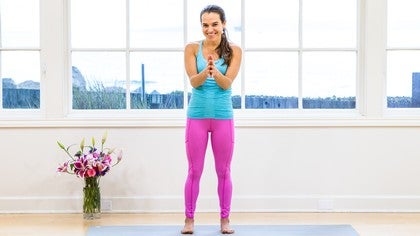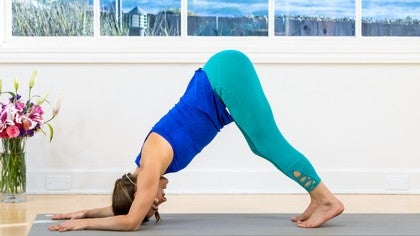Description
This lesson is designed to go along with Practice 1.
About This Video
Transcript
Read Full Transcript
So welcome to Lesson 1. This will be our longest lesson. We'll start with what is yoga and what makes yoga yoga. How do we differentiate the techniques or practices of yoga with an experience of yoga, right? So the yogi suggests that the aim of yoga is to really uncover or reveal one's own true nature. Now this is quite ambitious. How can we do this? Well they say through cultivating steady attention, awareness, and ease. So in this course we start with our body. It's right here. It's what we're working with. So the invitation of yoga and throughout this course is to work with our attention, work with our awareness, and bring it into the body through our breathing, through our breath. So throughout these practices I'll invite you and encourage you to notice the quality of your breathing. Is it short? Is it shallow? Are you holding your breath? Is there a feeling of lengthening and deepening the breath? And I find the breath is such a useful feedback mechanism to know how my practice is going. Where can I find a bit more ease within the effort of holding a posture or exploring a posture? Throughout these practices I'll be inviting you to pause in between and notice how you feel. And I find that this is really where the magic of yoga reveals itself in the space in the pause between movement to really examine the sensation through the body. And as you move through these practices with sensation notice again how it feels. So there's like a good pain and there's a pain that's not so good. Generally a good pain in yoga, there's a kind of a curious feeling. Maybe it's a new feeling, you've never done it. It's a maybe it's a dull achy stretch or maybe you feel a bit sore afterwards or maybe you feel relief during or after your practice. Generally a bad pain is like a sharp specific maybe a searing quality where deep inside you know this does not feel right. Maybe you feel a bit more rigid or a bit more hesitant or even a little nervous. So it's really important throughout your practice to notice the sensation and to become sensitive to how you're feeling and always honest. If and when you meet what we would consider a bad pain in practice, if it's sharp, if it's specific, if it hurts always back out of it, always come out of it. If you find as you're moving through your practice that there's a good type of pain where it's curious, where you're interested, where maybe it's a new sensation or edge for you, I would just encourage you to move slowly and investigate and give it a bit more room to reveal itself over time. So on this note of good pain versus bad pain, it's not uncommon as you come up from a forward bend or an inversion to feel somewhat light-headed or dizzy or maybe even a little nauseous and you might try just moving a little bit slower as you come out of the forward bend. You might try drinking more water and you might find that this helps or it changes over time. Maybe not but just it's important to just pay attention and move at a slower pace and know that it's common especially when you're starting anything new like a yoga practice. So we'll end each practice with our final relaxation Shavasana and it's a pose that's like near and dear to my heart. I feel it's absolutely essential and important and it's like when we're stopping to pause and notice but it's really an invitation to do that for a little longer, even a few minutes to just relax any effort in the mind, the breath, the body and just to allow yourself to move into a state of being rather than doing and notice the magic and the miracle and the experience of yoga. Usually in most yoga classes and in this course I use the word namaste to close the practice. What does that mean? Well it's a greeting in India. It's very common to greet someone namaste as an honoring of hello or goodbye. One of my favorite translations of namaste comes from our teacher Eric Schiffman on Yoga Anytime. His translation is something like the light of my awareness recognizes the light of your presence and so it's this beautiful way of just honoring like I see you, thank you. Let's try it together. Bring your hands together and we'll say namaste. So how do you know your practice is working? This is a really, this is a real question. This is an important question. One thing to start to pay attention to is how do you feel before your practice? How are you feeling during your practice and how do you feel after your practice? And what's the point of integrating the mind, our attention, our breath and our bodies? We'll start to notice how it plays out and influences your daily life. So your homework assignment is to pay attention to how are you sleeping at night? How are you feeling? How are your relationships with yourself, with your loved ones? Do you perhaps have a bit more patience in traffic or while you're waiting in a line somewhere? So again we're exploring and practicing these techniques or technologies of yoga to point towards perhaps a moment, a glimpse and experience of yoga. And for me yoga is a sense of connection, union, integration and a real deeper sense of belonging. Try this a few times this week. Try these practices out a few times. Let me know how it goes. I'm excited to begin this journey with you. See you in the next lesson.
Start Yoga: with Alana Mitnick
Comments
You need to be a subscriber to post a comment.
Please Log In or Create an Account to start your free trial.




















